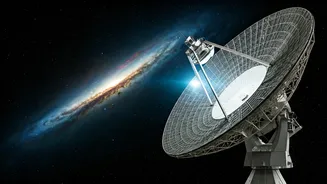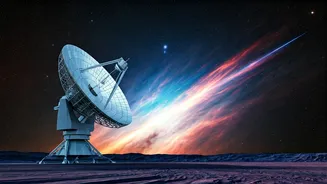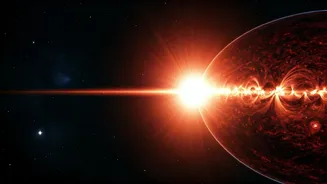Unveiling the Intruder
The interstellar object 3I/ATLAS, which scientists previously knew very little about, had left astronomers perplexed. The object, which entered our solar
system, captured the attention of researchers worldwide. The primary focus revolved around determining the origin and composition of this strange object. Initial observations presented a puzzle, as it did not behave as expected, and did not fit the profile of the usual comets or asteroids found in our solar system. The lack of clear information led to a concerted effort to gather more data. The search involved various instruments and techniques aimed at extracting even the smallest amount of information. Astronomers used sophisticated tools to analyze this object in the hopes of unraveling its mysteries.
Radio Signal Detection
The breakthrough came with the detection of a radio signal. This was an exciting find, as radio signals are often used to unveil details about an object's composition. Detecting this signal was no easy feat, as the signal was weak and required significant processing and analysis. The team of scientists had to filter out interference and interpret the data collected carefully. The discovery provided new perspectives that hinted at the object's origins, potentially tying it to specific regions within the galaxy. The radio signal, acting like a cosmic fingerprint, helped astronomers begin piecing together the object's journey across the vast expanse of space. This enabled them to begin building a more comprehensive understanding of its structure.
Deciphering Origins
The radio signal opened the door to understanding 3I/ATLAS's origins. Astronomers were able to analyze the frequency and characteristics of the signal to deduce the object's history and the materials it contained. This type of analysis helps to create a detailed map of an object. These studies allowed scientists to speculate on the conditions in which the object was formed and its interactions with other celestial bodies. The findings also raised questions about how similar objects might exist elsewhere. The implications of this discovery are significant. The study of 3I/ATAS could help us better understand the formation of our solar system and the processes that shape space. The discovery of interstellar objects has broadened our horizons, and opened new possibilities.
Future Research Awaits
This discovery is not an end but a beginning. With the detection of the radio signal, researchers are now eager to delve deeper. Further investigations using advanced telescopes and more sensitive instruments are planned. Scientists are preparing to collect even more detailed data, hoping to get a clearer picture of 3I/ATLAS. These future studies will focus on analyzing its composition, the specific materials it is made of, and the environments it might have traveled through. Additional study could allow scientists to better understand the processes involved in the formation of interstellar objects. Scientists are also interested in finding and studying more interstellar objects, because each one could provide additional information about the galaxy.











